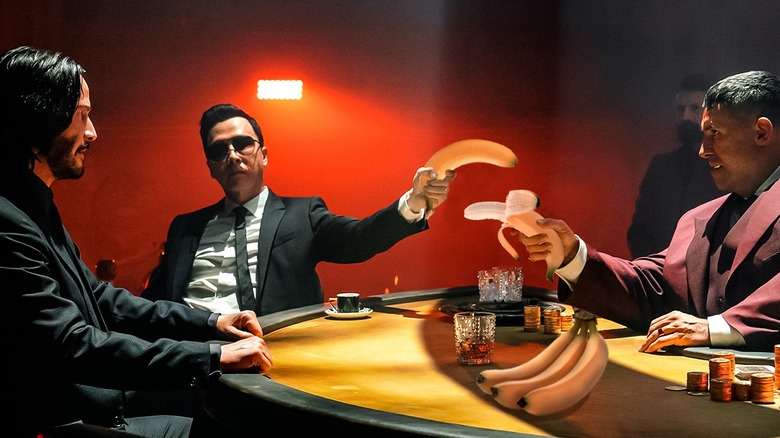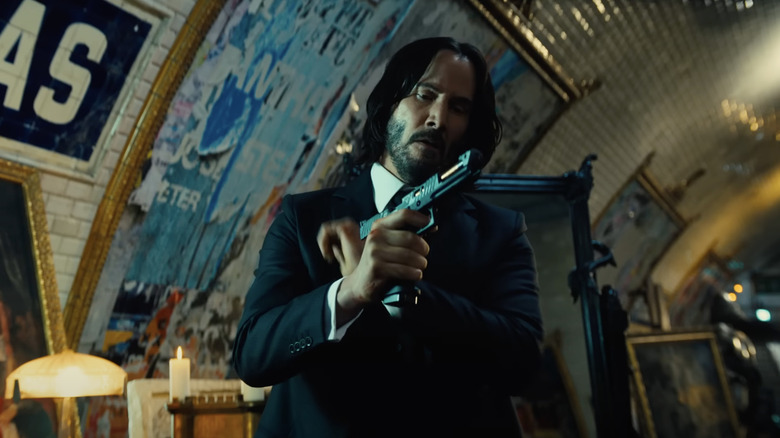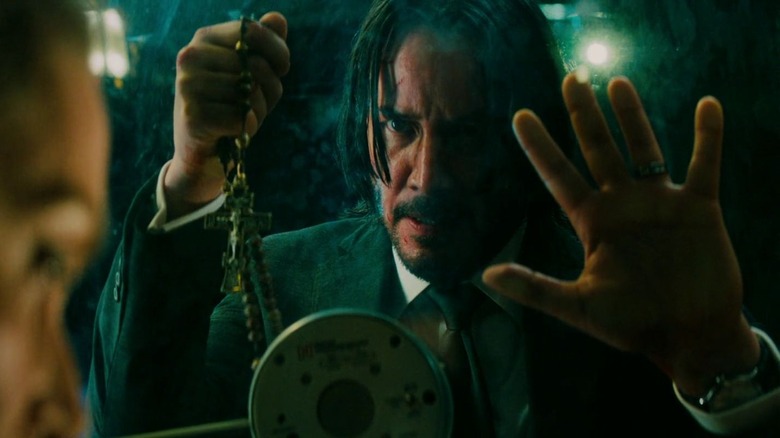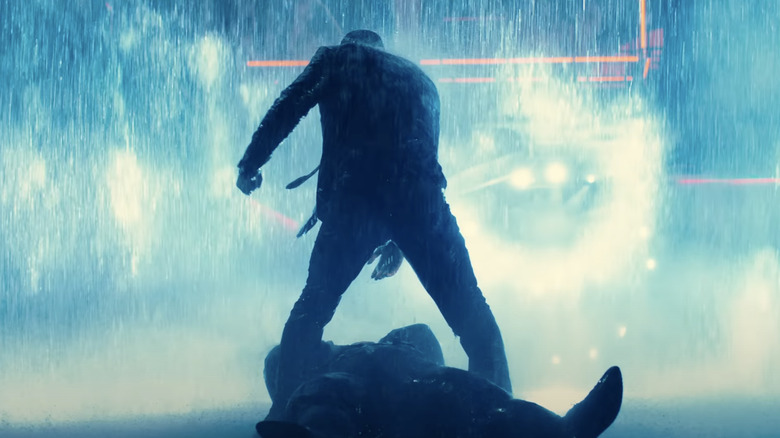The John Wick Movies, Or How I Learned To Put Aside The Gun Fetishization And Love The Series
In "John Wick: Chapter 2," there is a scene where Keanu Reeves' titular assassin meets with a man simply known as the Sommelier, played by Peter Serafinowicz. His speciality is not wine, though. It's guns. And the Sommelier goes onto present Wick with a smorgasbord of firearms as if he was recommending them for a multi-course meal of violence. When I saw the film back in February 2017, each presentation of a new gun accompanied by lines referring to them as "robust" or "dessert" generated a delighted guffaw from the audience. Meanwhile, I was squirming in my seat.
I hate guns. Living in the United States, a day doesn't pass where some horrific tragedy occurs involving a gun. To me, they are instruments of chaos and destruction, and the way so many people in this country fetishize and obsess over their weapons disturbs me deeply. I grew up with a fairly conservative father, and even he knew that guns didn't need to be around. The closest I ever got to one was a Super Soaker, and I never seemed to be having as much fun as anyone else playing with it. This belief that guns are cool never sits right with me.
Consequently, I struggle with a great number of action movies heavily reliant on their use of firearms. Movies that want you to marvel at the size of a gun or feature someone taking out a large number of bad guys with pinpoint precision do very little for me. So, while everyone was rejoicing at the arrival of the "John Wick" series, I was left feeling icky instead of thrilled. However, with "John Wick: Chapter 4" around the corner, I find myself incredibly excited to return to that world ... with "world" being the important word there.
A big gun problem: they're boring
My issues with guns are not simply limited to the carnage they cause in the real world. Cinematically, guns are often inert and, frankly, boring. When I like an action film, rarely do they prominently feature firearms. Take what I believe to be the three high watermarks of action cinema of the last 10 years: "Mission: Impossible — Fallout," "Mad Max: Fury Road," and "The Raid 2." These are films that thrive on their kineticism that let us marvel at the choreography. Car chases, hand-to-hand fights, jumping out of airplanes. These are the thrills best suited to action cinema. Always moving, always changing, and always carefully choreographed.
The first two "John Wick" films occasionally implement these sequences, but they are extremely gun-focused. Yes, these sequences are precisely put together, but there is a limit to my enjoyment when ultimately it is a guy standing and shooting at another guy who is standing and shooting. Making it even more distancing is that John Wick is in a completely bulletproof suit, thus minimizing any chance of him sustaining severe gunshot wounds. Combine these kinds of action set pieces with an overall adoration of guns, and I just found myself lost amongst the praise and adulation.
A regular person who hasn't particularly enjoyed the first two entries of a film series would probably just stop seeing them. Well, I am no ordinary person, and out of a sense of obligation to the cinematic medium, I went back to the theater to see "John Wick: Chapter 3 — Parabellum." And it was watching that movie that my entire perspective on the series flipped.
The magic of Parabellum
The first "John Wick" film established that the world of the series is not exactly the one we live in. It set up an underground society of assassins that abided by its own rules and codes, with Ian McShane's Winston acting as its ringmaster. But that film could only introduce these elements in small doses, as it was a relatively small-budgeted action picture capitalizing on its high concept premise: John Wick takes revenge on the people who stole his car and killed his dog. I always appreciated the world building elements of the first two films, but it wasn't until the third that they let it bloom. With "John Wick: Chapter 3 — Parabellum," the budget nearly quadrupled ($75 million compared to the original's $20 million), and the filmmakers have been given the license to go hog wild with the world they've created.
We see that this society isn't strictly limited to New York City, as Wick makes his way to Casablanca. We are introduced to characters like Asia Kate Dillon's The Adjudicator, Anjelica Huston's The Director, and Saïd Taghmaoui's The Elder. The further the film stepped outside the realm of real life and into this fantastical crime space, the more I gravitated to the story and characters populating it. And the more I can connect to those things, the more I can appreciate with the action set pieces they are involved in, whether Wick's fighting off katana-wielding henchmen on motorcycles, killing NBA nice guy Boban Marjanović with a book, or, yes, even shooting people with guns. With this lens, I could go back to the first two films and see the guns as an extension of this fantasy world and not as the real world death machines they are.
Bring on Chapter 4
Look, I am still not completely accepting of the "John Wick" series' love of guns. In the trailer for "John Wick: Chapter 4" (which I am still annoyed doesn't add an extra element to the title, thus making each title longer than the last), one of the big moments — one that causes the music to drop out to signal its importance — is for John Wick to say to Laurence Fishburne's The Bowery King, "I'm going to need a gun." It's one of those moments that is meant to make everyone in the audience go, "Oh, f*** yeah," and fist pump into the air. Me? I still wince at it.
But I can also see all the imagination around it. This neon-tinged underground continues to reveal itself with new subgroups, new rules, new allegiances, and new histories, and I am eager to learn all about them. For some people, this world expansion has pulled the films away from the original film's emotional core that hooked them at the beginning. From my perspective, the less real the "John Wick" series becomes the more successful it is. And the less real these movies are, the less its use of guns feels like a celebration of an instrument of destruction. "John Wick: Chapter 4" sports a nearly three-hour running time, and if you would have told me a few years ago that I would be beaming with excitement to see it just a few hours after this piece gets published, I wouldn't have believed you in the slightest. Yet here we are, and the "John Wick" series is now one of my favorite franchises. This is a good reminder to always be open to changing your mind, especially about movies.



